PORSCHE CAYNNE 2011 2.G Information Manual
Manufacturer: PORSCHE, Model Year: 2011, Model line: CAYENNE, Model: PORSCHE CAYENNE 2011 2.GPages: 69, PDF Size: 11.14 MB
Page 11 of 69
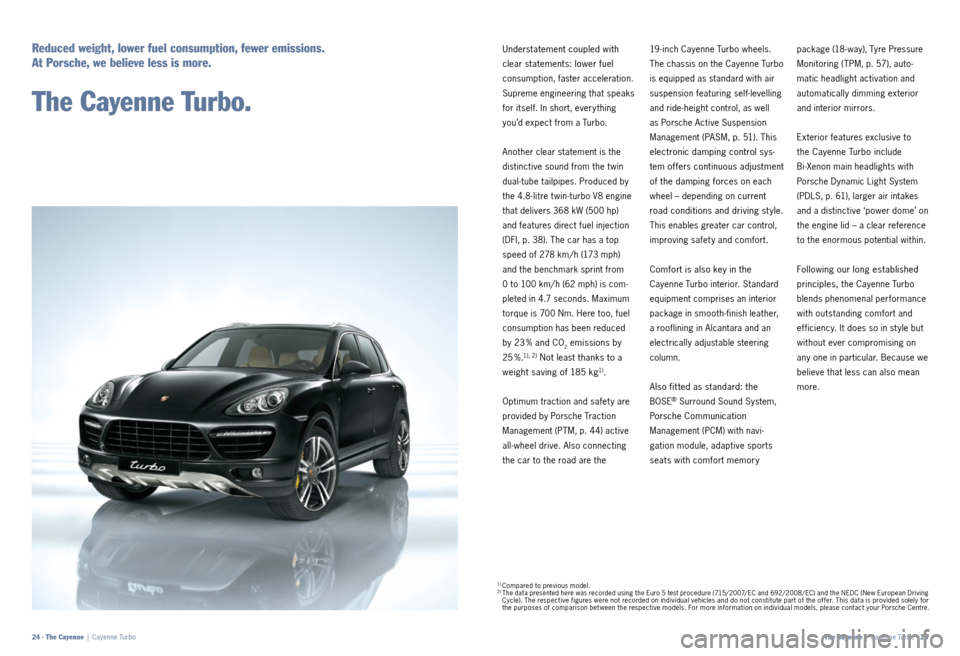
Understatement coupled with
clear statements: lower fuel
consumption, faster acceleration.
Supreme engineering that speaks
for itself. In short, every thing
you’d expect from a Turbo.
Another clear statement is the
distinctive sound from the t win
dual-tube tailpipes. Produced by
the 4.8-litre t win -turbo V8 engine
that delivers 368 kW (500 hp)
and features direct fuel injection
(DFI, p. 38). The car has a top
speed of 278 km/ h (173 mph)
and the benchmark sprint from
0 to 100 km/ h (62 mph) is com-
pleted in 4.7 seconds. Maximum
torque is 700 Nm. Here too, fuel
consumption has been reduced
by
23 % and CO2 emissions by
2 5 % .
1), 2) Not least thanks to a
weight saving of 185 kg
1).
Optimum traction and safet y are
provided by Porsche Traction
Management (PTM, p. 44) active
all-wheel drive. Also connecting
the car to the road are the 19 -inch Cayenne Turbo wheels.
The chassis on the Cayenne Turbo
is equipped as standard with air
suspension featuring self-levelling
and ride-height control, as well
as Porsche Active Suspension
Management
(PASM, p. 51). This
electronic damping control sys-
tem offers continuous adjustment
of the damping forces
on each
wheel – depending on
current
road conditions and driving st yle.
This enables greater car control,
improving safet y and comfort.
Comfort is also key in the
Cayenne Turbo interior. Standard
equipment comprises an interior
package in smooth-finish leather,
a rooflining in Alcantara and an
electrically adjustable steering
column.
Also fit ted as standard: the
BOSE® Surround Sound System,
Porsche Communication
Management (PCM) with navi-
gation module, adaptive sports
seats with comfort memor y package (18-way), Tyre Pressure
Monitoring (TPM, p. 57), auto -
matic headlight activation and
automatically dimming exterior
and interior mirrors.
Exterior features exclusive to
the Cayenne Turbo include
Bi-Xenon main headlights with
Porsche Dynamic Light System
(PDLS, p. 61), larger air intakes
and a distinctive ‘power dome’ on
the engine lid – a clear reference
to the enormous potential within.
Following our long established
principles,
the Cayenne Turbo
blends phenomenal performance
with outstanding comfort and
efficiency. It does so in st yle but
without ever compromising on
any one in particular. Because we
believe that less can also mean
more.
Reduced weight, lower fuel consumption, fewer emissions.
At Porsche, we believe less is more.
The Cayenne Turbo.
1) Compared to previous model.2) The data presented here was recorded using the Euro 5 test procedure (715/2007/ EC and 692/2008/ EC) and the NEDC (New European Driving Cycle). The respective figures were not recorded on individual vehicles and do not constitute part of the of fer. This data is provided solely for the purposes of comparison bet ween the respective models. For more information on individual models, please contact your Porsche Centre.
The Cayenne | Cayenne Turbo · 25
24 · The Cayenne | Cayenne Turbo
Page 12 of 69

How could we make the
Cayenne more powerful and yet,
at the same time, more efficient?
Where should we start? It ’s
obvious, really. 1948 – where
else? That ’s when the values
that we hold so dearly today –
and will continue to do so in
the future – were established.
Af ter all, is there any thing wrong
with having progressive concepts,
social responsibilit y and a clear
direction?
Page 13 of 69
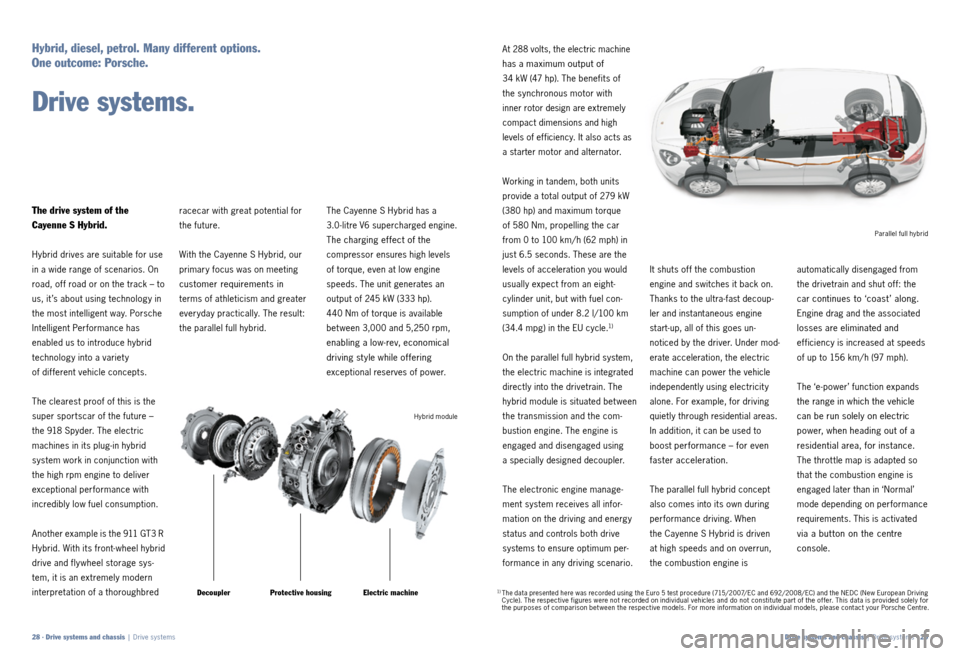
The Cayenne S Hybrid has a
3.0 -litre V6 supercharged engine.
The charging effect of the
compressor ensures high levels
of torque, even at low engine
speeds. The unit generates an
output of 245 kW (333 hp).
440 Nm of torque is available
bet ween 3,000 and 5,250 rpm,
enabling a low-rev, economical
driving st yle while offering
exceptional reserves of power.
At 288 volts, the electric machine
has a maximum output of
34 kW (47 hp). The benefits of
the synchronous motor with
inner rotor design are extremely
compact dimensions and high
levels of efficiency. It also acts as
a starter motor and alternator.
Working in tandem, both units
provide a total output of 279 kW
(380 hp) and maximum torque
of 580 Nm, propelling the car
from 0 to 100 km/ h (62 mph) in
just 6.5 seconds. These are the
levels of acceleration you would
usually expect from an eight-
cylinder unit, but with fuel con-
sumption of under 8.2 l/100 km
(34.4 mpg) in the EU cycle.
1)
On the parallel full hybrid system,
the electric machine is integrated
directly into the drivetrain. The
hybrid module is situated bet ween
the transmission and the com -
bustion engine. The engine is
engaged and disengaged using
a specially designed decoupler.
The electronic engine manage-
ment system receives all infor-
mation on the driving and energy
status and controls both drive
systems to ensure optimum per-
formance in any driving scen ario.
racecar with great potential for
the future.
With the Cayenne S Hybrid, our
primary focus was on meeting
customer requirements in
terms of athleticism and greater
everyday practically. The result:
the parallel full hybrid.
The drive system of the
Cayenne S Hybrid.
Hybrid drives are suitable for use
in a wide range of scenarios. On
road, of f road or on the track – to
us, it ’s about using technology in
the most intelligent way. Porsche
Intelligent Performance has
enabled us to introduce hybrid
technology into a variet y
of different vehicle concepts.
The clearest proof of this is the
super sportscar of the future –
the 918 Spyder. The electric
machines in its plug-in hybrid
system work in conjunction with
the high rpm engine to deliver
exceptional performance with
incredibly low fuel consumption.
Another example is the 911 GT3 R
Hybrid. With its front-wheel hybrid
drive and fly wheel storage sys-
tem, it is an extremely modern
interpretation of a thoroughbred
Hybrid, diesel, petrol. Many different options.
One outcome: Porsche.
Drive systems.
1) The data presented here was recorded using the Euro 5 test procedure (715/2007/ EC and 692/2008/ EC) and the NEDC (New European Driving Cycle). The respective figures were not recorded on individual vehicles and do not constitute part of the of fer. This data is provided solely for the purposes of comparison bet ween the respective models. For more information on individual models, please contact your Porsche Centre.
Drive systems and chassis | Drive systems · 29
28 · Drive systems and chassis | Drive systems Parallel full hybrid
It shuts of f the combustion
engine and switches it back on.
Thanks to the ultra-fast decoup-
ler and instantaneous engine
start-up, all of this goes un-
noticed by the driver.
Under mod-
erate
acceleration, the electric
machine can power the vehicle
independently using electricit y
alone. For example, for driving
quietly through residential areas
.
In
addition, it can be used to
boost
performance – for even
faster acceleration.
The parallel full hybrid concept
also comes into its own during
performance driving. When
the Cayenne S Hybrid is driven
at high speeds and on overrun,
the combustion engine is automatically disengaged from
the drivetrain and shut off: the
car
continues to ‘coast’ along.
Engine drag and the associated
losses are eliminated and
efficiency is increased at speeds
of up to 156 km/ h (97 mph).
The ‘e-power’ function expands
the range in which the vehicle
can be run solely on electric
power, when heading out of a
residential area, for instance.
The throt tle map is adapted so
that the combustion engine is
engaged later than in ‘Normal’
mode depending on performance
requirements. This is activated
via a but ton on the centre
console.
Hybrid module
Decoupler
Protective housing Electric machine
Page 14 of 69
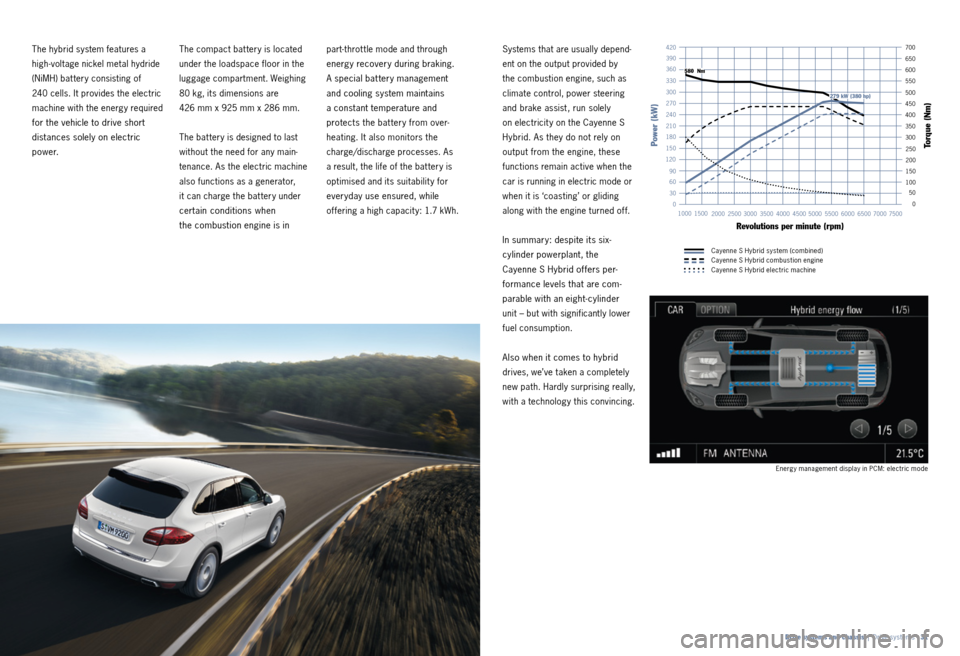
part-throt tle mode and through
energy recovery during braking.
A special bat tery management
and cooling system maintains
a constant temperature and
pro
tects the bat ter y from over-
heating. It also monitors the
charge/discharge processes. As
a result, the life of the bat tery is
optimised and its suitabilit y for
everyday use ensured, while
offering a high capacit y: 1.7 kWh. Systems that are usually depen d-
ent on the output provided by
the combustion engine, such as
climate control, power steering
and brake assist , run solely
on electricit y on the Cayenne S
Hybrid. As they do not rely on
output from the engine, these
functions remain active when the
car is running in electric mode or
when it is ‘coasting’ or gliding
along with the engine turned of f.
In summary: despite its six-
cylinder powerplant, the
Cayenne S Hybrid offers per-
formance levels that are com-
parable with an eight-cylinder
unit – but with significantly lower
fuel consumption.
Also when it comes to hybrid
drives, we’ve taken a completely
new path. Hardly surprising really,
with a technology this convincing.
The compact bat tery is located
under the loadspace floor in the
luggage compartment. Weighing
80 kg, its dimensions are
426 mm x 925 mm x 286 mm.
The bat tery is designed to last
without the need for any main-
tenance. As the electric machine
also functions as a generator,
it can charge the bat tery under
certain conditions when
the combustion engine is in
The hybrid system features a
high -voltage nickel metal hydride
(NiMH) bat tery consisting of
240 cells. It provides the electric
machine with the energy required
for the vehicle to drive short
distances solely on electric
power.
Drive systems and chassis | Drive systems · 31
Energy management display in PCM: electric mode
100 50
0
300350400450500
550600650
0
30 60 90
120
150 180 210 240 270 300 330
150200250
Power (kW)
Torque (Nm)Torque (Nm)T
1500
7500
2000 25003000 3500400045005000 5500600065007000
1000
Revolutions per minute (rpm)
360 390 420
700
580 Nm
279 kW (380 hp)
Cayenne S Hybrid system (combined)
Cayenne S Hybrid combustion engine
Cayenne S Hybrid electric machine
Page 15 of 69

Cayenne Diesel engineCayenne engine
Cayenne Di esel: 550 Nm bet ween 1,750 and 2,750 rpm , 1 80 kW (245 hp)
bet ween 3,800 and 4,400 rpm Cayenne: 400 Nm at 3,000 rpm
, 220 kW (300 hp) at 6,300 rpm
The Cayenne Diesel is powered
by a new 3.0 -litre V6 turbo - diesel
engine with a common-rail injec-
tion system. Its turbocharger
features Variable Turbine Geo -
metry (V TG, p. 40). The incoming
exhaust gases drive a set of
electronically variable turbine
blades whose angle is continuous-
ly adjusted to ensure optimum
performance under all engine
loads. This results in an output
of 180 kW (245 hp) and maximum
torque of 550 Nm. The car
accelerates from 0 to 100 km/ h
(62 mph) in 7.6 seconds. Max-
imum torque is available bet ween
1,750 and 2,750 rpm. Top speed
is 220 km/ h (137 mph), while fuel
consumption has been lowered.
1)
On all Cayenne petrol engines,
we have used direct fuel injection
(DFI, p. 38) to achieve a signi fi-
cant increase in specific power
and torque as well as bet ter fuel
economy and lower emissions.
1), 2)
The Cayenne features a naturally
aspirated 3.6-litre V6 engine
with direct fuel injection (DFI)
and variable valve timing on
both inlet and exhaust. The
unit delivers 220 kW (300 hp)
at 6,300 rpm and maximum
torque of 400 Nm at 3,000 rpm.
Maximum speed is 230 km/ h
(143 mph). The car requires
7.5 seconds to reach 100 km/ h
(62 mph) with a manual gearbox.
At the same time, fuel economy
has been improved by up to 20 %.
1)
The new engine of the Cayenne Diesel. The engine of the Cayenne.
1) Compared to previous model (Model Year 2011).2) The data presented here was recorded using the Euro 5 test procedure (715/2007/ EC and 692/2008/ EC) and the NEDC (New European Driving Cycle). The respective figures were not recorded on individual vehicles and do not constitute part of the of fer. This data is provided solely for the purposes of comparison bet ween the respective models. For more information on individual models, please contact your Porsche Centre.
Drive systems and chassis | Drive systems · 33
32 · Drive systems and chassis | Drive systems
100
300350400450500
550600650
0
30 60 90
120
150 180 210 240 270 300
3301500
7500
2000 25003000 3500400045005000 5500600065007000
150200250
1000
360700
390750800420
Power (kW)
Torque (Nm)Torque (Nm)T
Revolutions per minute (rpm)
220 kW (300 hp)
400 Nm
0
30 60 90
120 150 180 210 240 270 300 3301500
200025003000 35004000 45005000 55006000100
300
350
400
450
500
550
600
650
150
200
250
1000
550 Nm
180 kW (245 hp)
0
30 60 90
120
150 180 210 240 270 300 330
150020002500 300035004000 4500500055006000
1000
Leistung (kW)
Drehzahl (1 /min)
550 Nm
176kW (240 PS)
Power (kW)
Torque (Nm)Torque (Nm)T
Revolutions per minute (rpm)
Page 16 of 69
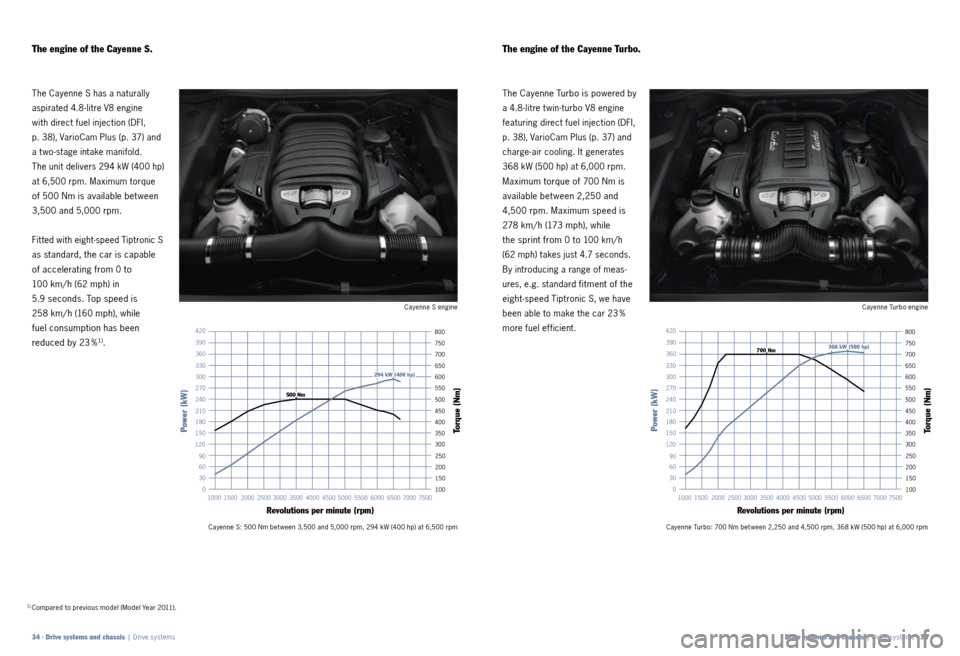
Cayenne S engineCayenne Turbo engine
The Cayenne S has a naturally
aspirated 4.8-litre V8 engine
with direct fuel injection (DFI,
p. 38), VarioCam Plus (p. 37) and
a t wo -stage intake manifold.
The unit delivers 294 kW (400 hp)
at 6,500 rpm. Maximum torque
of 500 Nm is available bet ween
3,500 and 5,000 rpm.
Fit ted with eight-speed Tiptronic S
as standard, the car is capable
of accelerating from 0 to
100 km/ h (62 mph) in
5.9 seconds. Top speed is
258 km/ h (160 mph), while
fuel consumption has been
reduced by 23 %
1).The Cayenne Turbo is
powered by
a 4.8-litre t win -turbo V8 engine
featuring direct fuel injection (DFI,
p. 38), VarioCam Plus (p. 37) and
charge-air cooling. It generates
368 kW (500 hp) at 6,000 rpm.
Maximum torque of 700 Nm is
available bet ween 2,250 and
4,500 rpm. Maximum speed is
278 km/ h (173 mph), while
the sprint from 0 to
100 km/ h
(62 mph) takes just 4.7 seconds.
By introducing a range of meas-
ures, e.g. standard
fitment of the
eight-speed
Tiptronic S, we have
been able to make the car 23 %
more fuel efficient.
The engine of the Cayenne S. The engine of the Cayenne Turbo.
Cayenne S: 500 Nm bet ween 3,500 and 5,000 rpm, 294 kW (400 hp) at 6,500 rpm Cayenne Turbo: 700 Nm bet ween 2,250 and 4,500 rpm, 368 kW (500 hp) at 6,000 rpm
Drive systems and chassis | Drive systems · 35
34 · Drive systems and chassis | Drive systems
100
300350400450500
550600650
0
30 60 90
120
150 180 210 240 270 300
3301500
7500
2000 25003000 3500400045005000 5500600065007000
150200250
1000
Power (kW)
Torque (Nm)Torque (Nm)T
Revolutions per minute (rpm)
360700
390750800420
294 kW (400 hp)
500 Nm
100
300350400450500
550600650
0
30 60 90
120
150 180 210 240 270 300
3301500
7500
2000 25003000 3500400045005000 5500600065007000
150200250
1000
Power (kW)
Torque (Nm)Torque (Nm)T
Revolutions per minute (rpm)
360700
390750800420
700 Nm368 kW (500 hp)
1) Compared to previous model (Model Year 2011).
Page 17 of 69
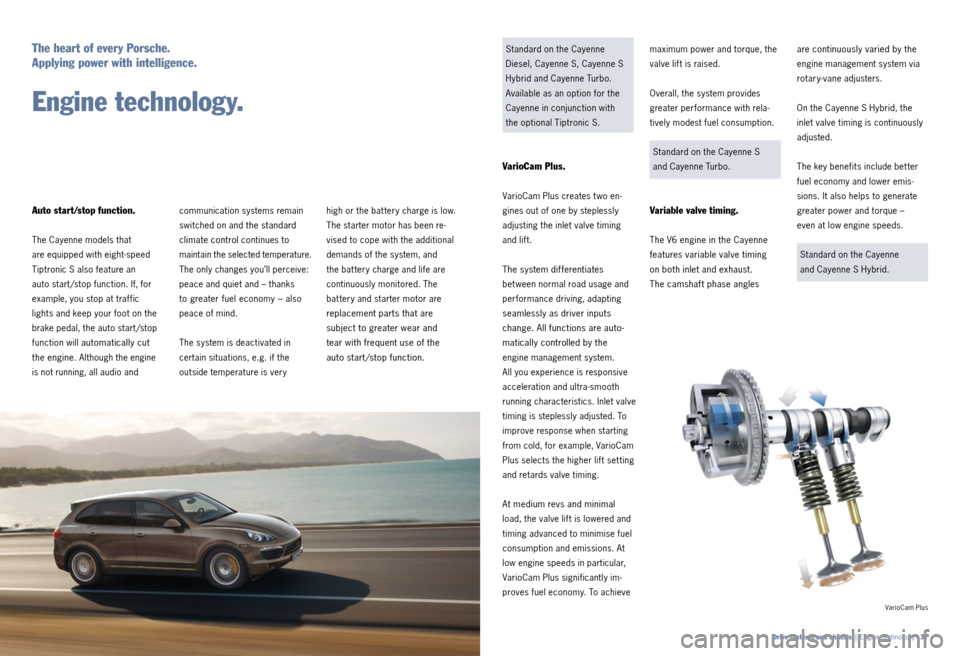
Standard on the Cayenne
Diesel, Cayenne S, Cayenne S
Hybrid and Cayenne Turbo.
Available as an option for the
Cayenne in conjunction with
the optional Tiptronic S.
VarioCam Plus.
VarioCam Plus creates t wo en-
gines out of one by steplessly
adjusting the inlet valve timing
and lift.
The system dif ferentiates
bet ween normal road usage and
performance driving, adapting
seamlessly as driver inputs
change. All functions are auto -
matically controlled by the
engine management system.
All you experience is responsive
acceleration and ultra-smooth
running characteristics. Inlet valve
timing is steplessly adjusted. To
improve response when starting
from cold, for example, VarioCam
Plus selects the higher lif t set ting
and retards valve timing.
At medium revs and minimal
load, the valve lif t is lowered and
timing advanced to minimise fuel
consumption and emissions. At
low engine speeds in particular,
VarioCam Plus significantly im-
proves fuel economy. To achieve maximum power and torque, the
valve lif t is raised.
Overall, the system provides
greater performance with rela-
tively modest fuel consumption.
Standard on the Cayenne S
and Cayenne Turbo.
Variable valve timing.
The V6 engine in the Cayenne
features variable valve timing
on both inlet and exhaust.
The camshaft phase angles are continuously varied by
the
engine management system via
rotary-vane adjusters.
On the Cayenne S Hybrid, the
inlet valve timing is continuously
adjusted.
The key benefits include bet ter
fuel economy and lower emis-
sions. It also helps to generate
greater power and torque –
even at low engine speeds.
Standard on the Cayenne
and Cayenne S Hybrid.
high or the bat tery charge is low.
The starter motor has been re-
vised to cope with the additional
demands of the system, and
the bat tery charge and life are
continuously monitored. The
bat tery and starter motor are
replacement parts that are
subject to greater wear and
tear with frequent use of the
auto start /stop function.
communication systems remain
switched on and
the standard
climate control
continues to
maintain the selected temperature.
The only changes you’ll perceive:
peace and quiet and – thanks
to greater fuel economy – also
peace of mind.
The system is deactivated in
certain situations, e.g. if the
outside temperature is very
Auto start/stop function.
The Cayenne models that
are equipped with eight-speed
Tiptronic S also feature an
auto start /stop function. If, for
ex ample, you stop at traf fic
lights and keep your foot on the
brake pedal, the auto start /stop
function will
automatically cut
the engine.
Although the engine
is not running,
all audio and
The heart of every Porsche.
Applying power with intelligence.
Engine technology.
VarioCam Plus
Drive systems and chassis | Engine technology · 37
Page 18 of 69
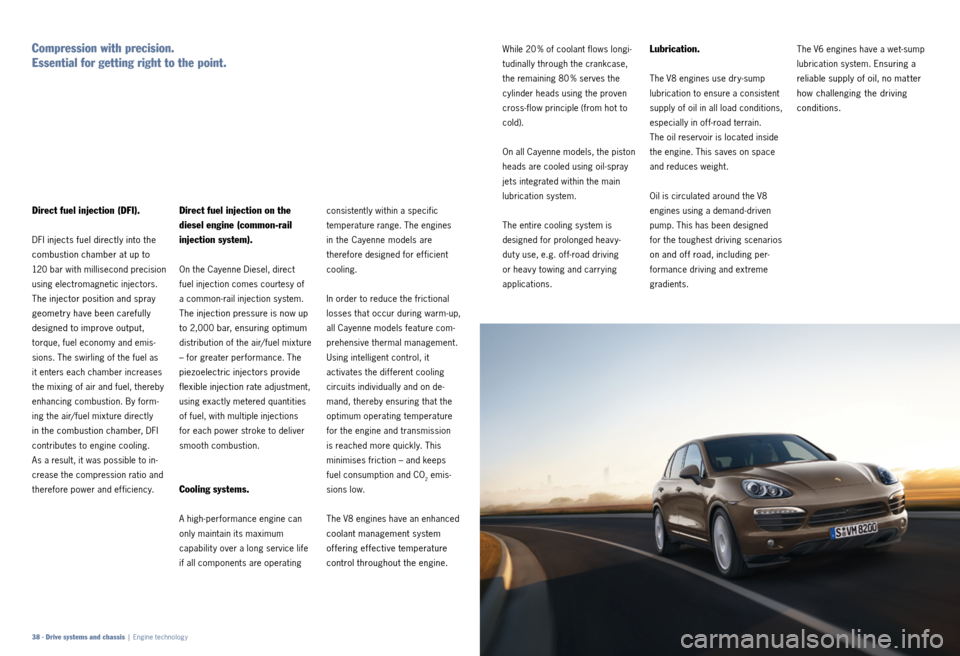
consistently within a specific
temperature range. The engines
in the Cayenne models are
therefore designed for ef ficient
cooling.
In order to reduce the frictional
losses that occur during warm -up,
all Cayenne models feature com-
prehensive thermal management.
Using intelligent control, it
activates the dif ferent cooling
circuits individually and on de-
mand, thereby ensuring that the
optimum operating temperature
for the engine and transmission
is reached more quickly. This
minimises friction – and keeps
fuel consumption and CO
2 emis-
sions low.
The V8 engines have an enhanced
coolant management system
offering effective temperature
control throughout the engine.
While 20 % of coolant flows longi-
tudinally through the crankcase,
the remaining 80 % serves the
cylinder heads using the proven
cross-flow principle (from hot to
cold).
On all Cayenne models, the piston
heads are cooled using oil-spray
jets integrated within the main
lubrication system.
The entire cooling system is
designed for prolonged heav y-
dut y use, e.g. of f-road driving
or heav y towing and carrying
applications.Lubrication.
The V8 engines use dry-sump
lubrication to ensure a consistent
supply of oil in all load conditions,
especially in of f-road terrain.
The oil reservoir is located inside
the engine. This saves on space
and reduces weight.
Oil is circulated around the V8
engines using a demand- driven
pump. This has been designed
for the toughest driving scenarios
on and off road, including per-
formance driving and extreme
gradients. The V6 engines have a wet-sump
lubrication system.
Ensuring a
reliable supply of oil, no mat ter
how challenging the driving
conditions.
Direct fuel injection on the
diesel engine (common-rail
injection system).
On the Cayenne Diesel, direct
fuel injection comes courtesy of
a common -rail injection system.
The injection pressure is now up
to 2,000 bar, ensuring optimum
distribution of the air/fuel mixture
– for greater performance. The
piezoelectric injectors provide
flexible injection rate
adjustment,
using exactly metered quantities
of fuel, with multiple injections
for each power stroke to deliver
smooth combustion.
Cooling systems.
A high -performance engine can
only maintain its maximum
capabilit y over a long service life
if all components are operating
Direct fuel injection (DFI).
DFI injects fuel directly into the
combustion chamber at up to
120 bar with millisecond precision
using electromagnetic injectors.
The injector position and spray
geometry have been carefully
designed to improve output,
torque, fuel economy and emis-
sions. The swirling of the fuel as
it enters each chamber increases
the mixing of air and fuel, thereby
enhancing combustion. By form-
ing the air/fuel mixture directly
in the combustion chamber, DFI
contributes to engine cooling.
As a result, it was possible to in-
crease the compression ratio and
therefore power and efficiency.
Compression with precision.
Essential for getting right to the point.
38 · Drive systems and chassis | Engine technology
Page 19 of 69

response, even at low revs and
road speeds. This is particularly
useful when driving in urban
traf fic. The supercharger has a
low-temperature water cooling
system for cooling the charge air.
Variable Turbine Geometry in
the Cayenne Diesel.
The turbocharger in the
Cayenne Diesel features Variable
Turbine Geometry (V TG). The
gas-flow from the engine is
channelled onto the turbines via
electronically adjustable guide
vanes. By changing the vane
angle, the system can replicate
the geometry in all t ypes of
turbo, large or small , and thus
achieve the optimum gas-flow characteristics. As a result, even
at low engine rpm, the turbine
speed is maximised. For a sig-
nificant increase in boost pres-
sure, excellent cylinder charging
plus greater power and torque.
Electronic engine management.
Cultured performance in all
driving scenarios requires com-
prehensive engine control. The
electronic engine management
system does this by continually
monitoring the relevant input data
from a variet y of sophisticated
sensors. This data is then com-
pared with a corresponding set of
reference values. Based on this
information, a range of key engine
functions, e.g. ignition and in-
jection timings as well as injection
quantities, are seamlessly and
automatically adjusted. Other
major functions include on -board
recuperation. It ensures that the
on -board power supply is only
replenished while the vehicle is
on the overrun. This boosts fuel
economy as well as performance,
and ensures maximum engine
output during acceleration. All
this goes unnoticed by the driver,
apart from the obvious benefits:
lower fuel consumption and CO
2
emissions plus greater power and
torque at all times.
Exhaust system.
The light weight exhaust systems
in the Cayenne models are made
from special, long-life stainless
steel. The key features of the cata-
lysts are high ef ficiency, faster
warm -up and a long service life.
Sports exhaust system.
Available as an option on the
Cayenne and Cayenne S, the
sports exhaust system
1) provides
an even more distinctive sound.
For the looks to match, it comes
with a specially designed set
of t win dual-tube tailpipes with
a high-gloss finish.
All exhaust systems, standard and
sports, comply with the stringent
EU5 emissions legislation.
2)
Turbocharging system in the
Cayenne Turbo.
In the Cayenne Turbo, the engine
is assisted by t win turbocharger
units arranged in parallel –
one for each bank of cylinders.
Incoming air is passed through
a filter and compressed by the
turbine units. Its temperature is
then reduced in the t win inter-
cooler system, which improves
cylinder charging and limits
thermal loads on the engine.
Supercharging system in the
Cayenne S Hybrid.
The engine in the Cayenne S
Hybrid is equipped with a
supercharger. For a more direct
Air intake system.
The Cayenne models are all
equipped with a resonance air
intake system. This technology
uses the pressure waves
generated by the inlet valves
to ‘force’ air into the engine.
The ef fect is enhanced in the
Cayenne and Cayenne S by a
t wo -stage intake manifold. This
variable geometry combines
all the benefits of a long intake
tube (higher torque at low rpm)
with those of a shorter length
(more power at higher rpm).
The result: highly impressive
torque ratings across the entire
engine speed range.
1 ) For Cayenne only in conjunction with Tiptronic S.2) The data presented here was recorded using the Euro 5 test procedure (715/2007/ EC and 692/2008/ EC) and the NEDC (New European Driving Cycle). The respective figures were not recorded on individual vehicles and do not constitute part of the of fer. This data is provided solely for the purposes of comparison bet ween the respective models. For more information on individual models, please contact your Porsche Centre.
Tailpipes on the Cayenne, Cayenne Diesel, Cayenne S and Cayenne S Hybrid
Tailpipes on the Cayenne Turbo
Drive systems and chassis | Engine technology · 41
Spor ts exhaust system (optional)
Page 20 of 69
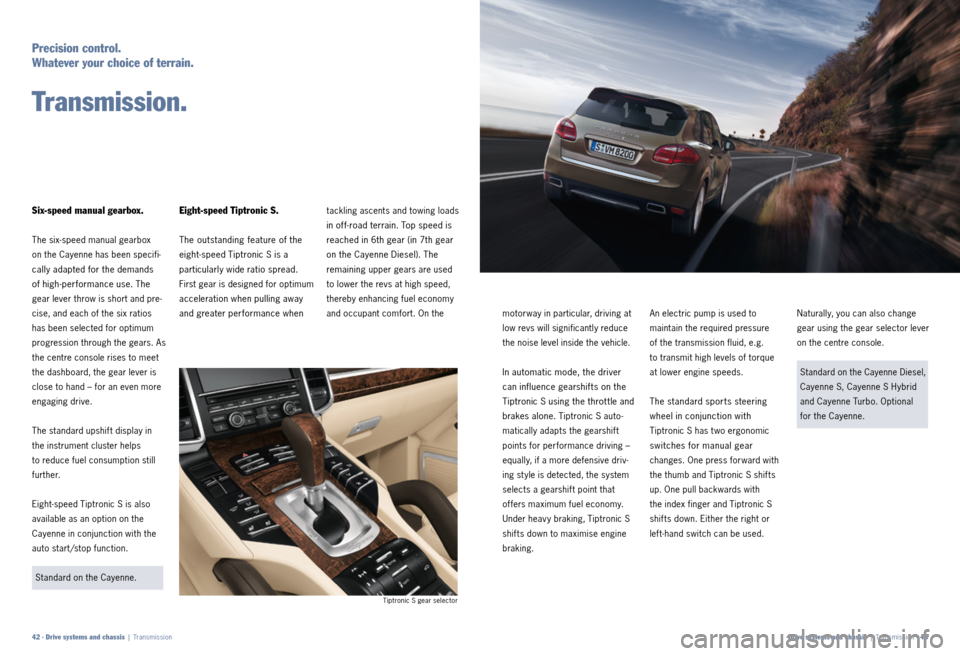
An electr ic pump is used to
m a i ntain the r equired p re ssu re
of the t ransmis sion fluid , e.g.
to t ransmit high l evels of torque
at lower engine speeds.
The s tanda rd sports steering
wheel in conjunction with
T i p t r o nic S h as t wo e rgonom ic
switch es for manual gear
c h a n g es. One p re ss forwa rd with
the thumb and Tiptronic S shif ts
up. One pull backwa rds with
the in dex finger and Tiptronic S
shif ts down. Either the right or
l eft-hand switch can be used.
tackling a
sce nts and towing loads
in off-road ter rain. Top speed is
reached in 6th gear (in 7th gear
on the Cayenne Diesel). The
remaining
upper gea rs a re used
to lower the r evs at high speed ,
the reby enhancing fuel economy
and occupa nt comfo rt. On the motorway in particular , driving at
low r evs will s ignifica ntly r educe
the noise l evel insid e the veh ic le.
In automatic mode, the driver
can influence gea rshifts on the
Tiptron ic S using the throt t le and
b rak es alone.
Tiptronic S auto -
mat ically adapts the gea rshif t
points for performance driving –
equally , if a mo re d efen sive driv-
ing s tyle is d etec ted , the sy stem
se lects a gea rshift poi nt that
o f f e rs maximum fuel economy.
Un der heav y b raking , Tiptron ic S
shifts down to maxi mise engine
b raking. Natu
rally , you can also change
gear u sing the gear se lector lever
on the ce ntr e cons ole.
Standard on the Cayenne Diesel,
Cayenne S, Cayenne S Hybrid
and Cayenne Turbo. Optional
for the Cayenne.
Eight-speed Tiptronic S.
The out standing featu re of the
eight-speed Tiptron ic S is a
pa rticularly wi de ratio sp read.
Fi rs t gear is designed for optimum
acceleration when pulling away
and g rea ter performance when
Six-speed manual gearbox.
The six-speed manual gearbox
on the Cayenne has been specifi-
cally adapted for the demands
of high-performance use. The
gear lever throw is short and pre-
cise, and each of the six ratios
has been selected for optimum
progression through the gears. As
the centre console rises to meet
the dashboard, the gear lever is
close to hand – for an even more
engaging drive.
The standard upshif t display in
the instrument cluster helps
to reduce fuel consumption still
further.
Eight-speed Tiptronic S is also
available as an option on the
Cayenne in conjunction with the
auto start /stop function.
Standard on the Cayenne.
Precision control.
Whatever your choice of terrain.
Transmission.
Tiptronic S gear selector
42 · Drive systems and chassis | Transmission Drive systems and chassis | Transmission · 43